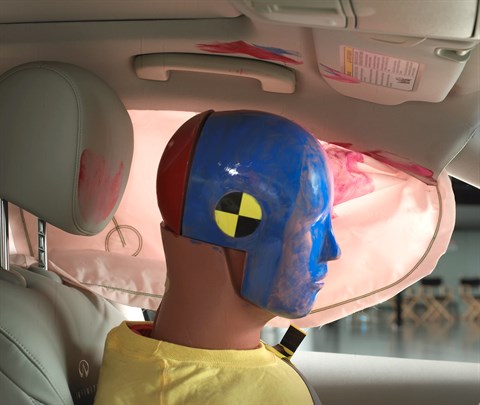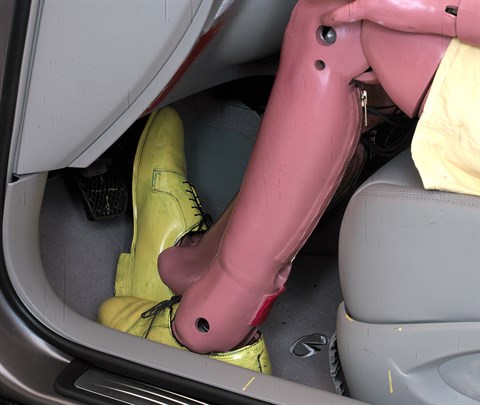Moderate overlap front: original test
Rating applies to 2014-17 models
Tested vehicle: 2008 Infiniti EX35 Journey 4-door 4wd
The Infiniti EX35 was introduced in the 2008 model year and renamed the EX37 in the 2013 model year because the engine size was increased. The EX was renamed the QX50 beginning with the 2014 model year.
| Evaluation criteria | Rating |
|---|---|
| Overall evaluation | |
| Structure and safety cage | |
| Driver injury measures | |
| Head/neck | |
| Chest | |
| Leg/foot, left | |
| Leg/foot, right | |
| Driver restraints and dummy kinematics | |

Action shot taken during the frontal offset crash test.

The dummy's position in relation to the steering wheel and instrument panel after the crash test indicates that the driver's survival space was maintained well.

Smeared greasepaint indicates where the dummy's head brushed the side airbag during rebound. The head also hit the roof, sunvisor, and grab handle before moving back against the head restraint.

Intrusion into the driver's space was minimal, and all leg and foot injury measures were low.
Side: original test
Rating applies to 2016-17 models
Tested vehicle: 2016 Infiniti QX50 4-door 4wd
The Infiniti EX35 was introduced in the 2008 model year and renamed the EX37 in the 2013 model year. The vehicle was then renamed the QX50 beginning with the 2014 model year.
Starting with the 2016 model year, the QX50's wheelbase and overall length were increased primarily for more rear seat room. Side ratings are assigned by the Institute based on a test of a 2016 QX50 conducted by Nissan.
| Evaluation criteria | Rating |
|---|---|
| Overall evaluation | |
| Structure and safety cage | |
| Driver injury measures | |
| Head/neck | |
| Torso | |
| Pelvis/leg | |
| Driver head protection | |
| Rear passenger injury measures | |
| Head/neck | |
| Torso | |
| Pelvis/leg | |
| Rear passenger head protection | |
Head restraints & seats
Seat type: Power leather seats with manual adjustable lumbar AHR
| Overall evaluation | |
|---|---|
| Dynamic rating | |
| Seat/head restraint geometry |
About the head restraint & seat test
Currently, IIHS tests apply only to front seats.
Headlights
Ratings are given for 2 different headlight variations available on this vehicle.
Trim level(s)
- All trims equipped with Deluxe Touring package
| Evaluation criteria | Rating |
|---|---|
| Low-beam headlight type | HID projector |
| High-beam headlight type | Halogen reflector |
| Curve-adaptive? | Yes |
| High-beam assist? | No |
|
Overall rating | |
| Distance at which headlights provide at least 5 lux illumination: | |
Low beams
On the straightaway, visibility was fair on both sides of the road. On curves, visibility was good on both right curves, fair on the sharp left curve and inadequate on the gradual left curve.
The low beams never exceeded glare limits.
High beams
On the straightaway, visibility was good on the right side of the road and inadequate on the left side. On curves, visibility was good on the gradual right curve, fair on the sharp right curve and inadequate on both left curves.
Trim level(s)
- All trims
| Evaluation criteria | Rating |
|---|---|
| Low-beam headlight type | Halogen projector |
| High-beam headlight type | Halogen reflector |
| Curve-adaptive? | No |
| High-beam assist? | No |
|
Overall rating | |
| Distance at which headlights provide at least 5 lux illumination: | |
Low beams
On the straightaway, visibility was fair on the right side of the road and inadequate on the left side. On curves, visibility was inadequate in all 4 tests.
The low beams never exceeded glare limits.
High beams
On the straightaway, visibility was good on the right side of the road and inadequate on the left side. On curves, visibility was inadequate in all 4 tests.
Front crash prevention: vehicle-to-vehicle
Child seat anchors
Rating applies to 2016-17 models
| Evaluation criteria | Rating |
|---|---|
| Overall evaluation | |
| Vehicle trim | S |
| Seat type | leather |
This vehicle has 2 rear seating positions with complete child seat attachment (LATCH) hardware.
It has 1 additional seating position with a tether anchor only.
| Evaluation criteria | Rating |
|---|---|
| Overall evaluation | |
| Vehicle trim | S |
| Seat type | leather |
| Rating icon | Rating |
|---|---|
| G | Good |
| A | Acceptable |
| M | Marginal |
| P | Poor |
| Seating positions that rely on borrowed lower anchors or have only a tether anchor available are not rated. | |
thether anchor symbol | Tether anchor |
lower anchor symbol | Lower anchors |
| Lower anchor(s) can be borrowed from adjacent positions(s) | |
| No hardware available |
Details by seating position
| Position | Rating |
|---|---|
| 1 | |
| Tether anchor | |
| easy-to-find location | |
| no other hardware could be confused for anchor | |
| Lower anchors | |
| too deep in seat | |
| not too much force needed to attach | |
| difficult to maneuver around anchors | |
| 2 | |
| Tether anchor | |
| easy-to-find location | |
| no other hardware could be confused for anchor | |
| Lower anchors | |
| none available | |
| 3 | |
| Tether anchor | |
| easy-to-find location | |
| no other hardware could be confused for anchor | |
| Lower anchors | |
| too deep in seat | |
| too much force needed to attach | |
| difficult to maneuver around anchors |
